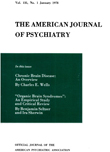OPIUM AS A TRANQUILIZER
Abstract
We have seen in our survey that our current search for a drug that will calm without sedating is not in any sense new. Over the centuries opium has been used as a tranquilizer and also for its effect as a hypnotic. It was used throughout the spectrum of psychiatric diagnoses but primarily for hysteria and hypochondriasis in its earliest history, then for mania for over a century, and more recently in the treatment of melancholia. Its use in psychiatry reached a peak in the middle of the 19th century, when many doctors considered it the greatest pharmaceutical aid that psychiatry had available. It was about this same time however that this favored psychiatric treatment began to be considered an occasional cause of mental illness and finally as morphinomania, a psychiatric disease itself. But not all psychiatrists recognized it as a disease, and we see in the late 19th century a final irony in the fact that as overcrowding increasingly plagued mental hospitals, addicts whose condition was frequently caused by physicians were turned away in favor of patients with other types of disorders.
Access content
To read the fulltext, please use one of the options below to sign in or purchase access.- Personal login
- Institutional Login
- Sign in via OpenAthens
- Register for access
-
Please login/register if you wish to pair your device and check access availability.
Not a subscriber?
PsychiatryOnline subscription options offer access to the DSM-5 library, books, journals, CME, and patient resources. This all-in-one virtual library provides psychiatrists and mental health professionals with key resources for diagnosis, treatment, research, and professional development.
Need more help? PsychiatryOnline Customer Service may be reached by emailing [email protected] or by calling 800-368-5777 (in the U.S.) or 703-907-7322 (outside the U.S.).



